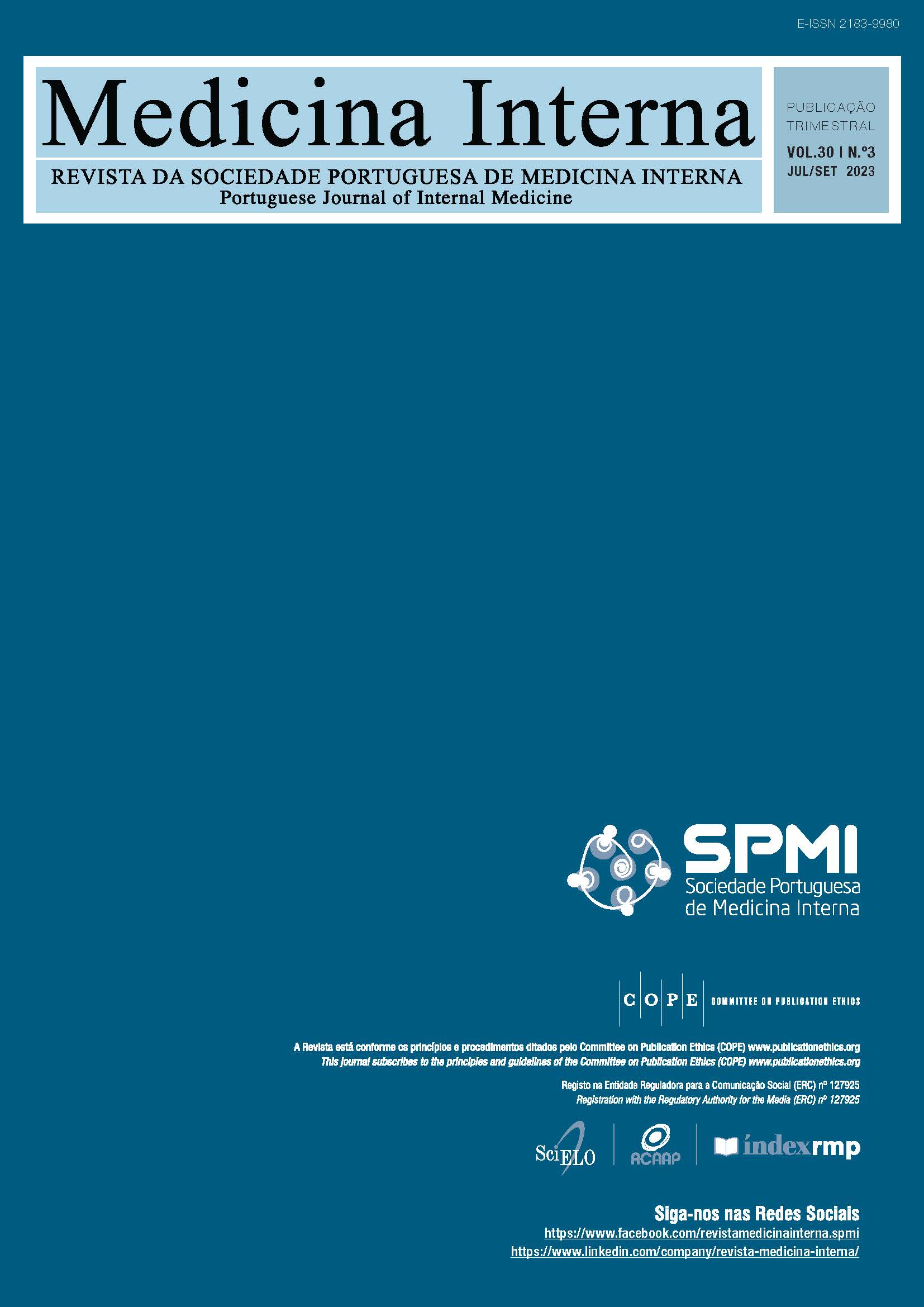Prevalence and Management of Delirium in Inpatient and Home-Based Palliative Care Patients
DOI:
https://doi.org/10.24950/rspmi.1752Keywords:
Delírium, Palliative CareAbstract
Introduction: Delirium is one of the most frequent complications in palliative care with a prevalence as high as 88% in the days preceding the end-of-life. Data on delirium home-based palliative care are scarce. The aim of this work is to characterize the population followed by a palliative care team, both in-hospital and at home, to assess the prevalence of delirium, the therapeutic strategy, its resolution, and the factors associated with the higher or lower prevalence of delirium.
Methods: A retrospective cohort study was carried out,
including all patients followed in the hospital and at home by a
palliative care team in Portugal during the year of 2019.
Results: A total of 496 patients were included, of whom 308 (62.1%) had in-hospital follow-ups. Delirium was identified in 112 (22.6%) of all patients and the first line drug used was haloperidol (51.8%). A total of 283 (57.1%) patients died, of whom 81 (28.6%) developed delirium. The occurrence of death was significantly higher in those who developed delirium (72.3%, p <0.001). Associated with higher incidence of delirium were identified in-hospital follow-up (27.9%, p <0.001), infection (53.9%, p <0.001), endocrine (84.6%, p <0.001) and ionic changes (55.0%, p <0.001), use of anticholinergics (54.1%, p = 0.001), antipsychotics (42.6%, p = 0.031), corticosteroids (37.7%, p = 0.008), and presence of brain metastasis (50.0%, p = 0.046).
Conclusion: There is a significant prevalence of delirium in end-of-life patients, which is a predictor of poor prognosis. The implementation of quality palliative care with a multidisciplinary approach may provide more effective control of delirium and reduce its overall prevalence.
Downloads
References
Setters B, Solberg LM. Delirium. Prim Care. 2017;44:541-59. doi: 10.1016/j.pop.2017.04.010.
Bramati P, Bruera E. Delirium in palliative care. Cancers. 201;13:5893. doi: 10.3390/cancers13235893.
Organização Mundial da Saúde. ICD-11 for Mortality and Morbidity Statistics [Internet]. 2020. 2020 [accessed 2022 Aug 30]. Available at: https://icd. who.int/browse11/l-m/en. Available from: https://icd.who.int/browse11/l-m/en#/http%3A%2F%2Fid.who.int%2Ficd%2Fentity%2F897917531
Bush SH, Tierney S, Lawlor PG. Clinical Assessment and Management of Delirium in the Palliative Care Setting. Drugs. 2017;77:1623–43. doi: 10.1007/s40265-017-0804-3.
Marcantonio ER. Delirium in hospitalized older adults. N Engl J Med. 2017;377:1456–66. doi: 10.1056/NEJMcp1605501.
Recchia A, Rizzi B, Favero A, Nobili A, Pasina L. Prevalence of delirium in end-of-life palliative care patients: an observational study. Med Princ Pract. 2022;31:118-24. doi: 10.1159/000521994.
Wilson JE, Mart MF, Cunningham C, Shehabi Y, Girard TD, MacLullich AM, et al. Delirium. Nat Rev Dis Primers. 2020;6:90. doi: 10.1038/s41572-020-00223-4. Erratum in: Nat Rev Dis Primers. 2020;6:94.
Davis DHJ, Muniz-Terrera G, Keage HA, Stephan BC, Fleming J, Ince PG, et al. Association of delirium with cognitive decline in late life: a neuropathologic study of 3 population-based cohort studies. JAMA Psychiatry. 2017;74:244-51. doi: 10.1001/jamapsychiatry.2016.3423.
Rebelo CC, Oliveira H. Abordagem do Delirium na Comunidade. Gaz Med. 2021;8:263–73.
Portela Millinger F, Fellinger M. Clinical characteristics and treatment of delirium in palliative care settings. Memo - Mag Eur Med Oncol. 2021;14:48–52.
Watt CL, Momoli F, Ansari MT, Sikora L, Bush SH, Hosie A, et al. The incidence and prevalence of delirium across palliative care settings: A systematic review. Palliat Med. 2019;33:865–77. doi: 10.1177/0269216319854944.
Breitbart W, Alici Y. Agitation and delirium at the end of life: "We couldn't manage him". JAMA. 2008;300:2898-910, E1. doi: 10.1001/jama.2008.885.
Featherstone I, Hosie A, Siddiqi N, Grassau P, Bush SH, Taylor J, et al. The experience of delirium in palliative care settings for patients, family, clinicians and volunteers: A qualitative systematic review and thematic synthesis. Palliat Med. 2021;35:988–1004. doi: 10.1177/02692163211006313.
Jackson KC, Lipman AG. Drug therapy for delirium in terminally ill patients. Cochrane Database Syst Rev. 2004:CD004770. doi: 10.1002/14651858. CD004770. Update in: Cochrane Database Syst Rev. 2012;11:CD004770.
National Clinical Guideline Center. DELIRIUM: diagnosis, prevention and management Update information. Clin Guidel 103 [Internet]. [accessed 2022 July]. Available at: Available from: www.nice.org.uk/guidance/cg103
Bush SH, Lawlor PG, Ryan K, Centeno C, Lucchesi M, Kanji S, et al. Delirium in adult cancer patients: ESMO Clinical Practice Guidelines. Ann Oncol. 2018;29:iv143–65. doi:10.1093/annonc/mdy147
Cole MG, Ciampi A, Belzile E, Zhong L. Persistent delirium in older hospital patients: a systematic review of frequency and prognosis. Age Ageing. 2009;38:19–26. doi: 10.1093/ageing/afn253.
Carlson B. Delirium in patients with advanced cancer. Lancet Oncol. 2016;17:e379. doi: 10.1016/S1470-2045(16)30380-1.
Bruera E, Miller L, McCallion J, Macmillan K, Krefting L, Hanson J. Cognitive failure in patients with terminal cancer: a prospective study. J Pain Symptom Manage. 1992;7:192–5.
Published
Versions
- 2023-09-27 (2)
- 2023-08-31 (1)
How to Cite
Issue
Section
Categories
License
Copyright (c) 2023 Internal Medicine

This work is licensed under a Creative Commons Attribution 4.0 International License.
Copyright (c) 2023 Medicina Interna






